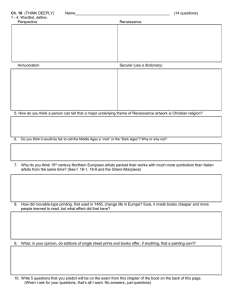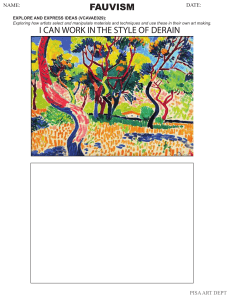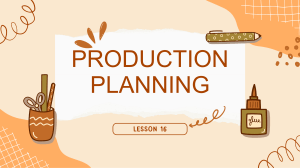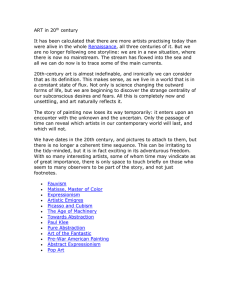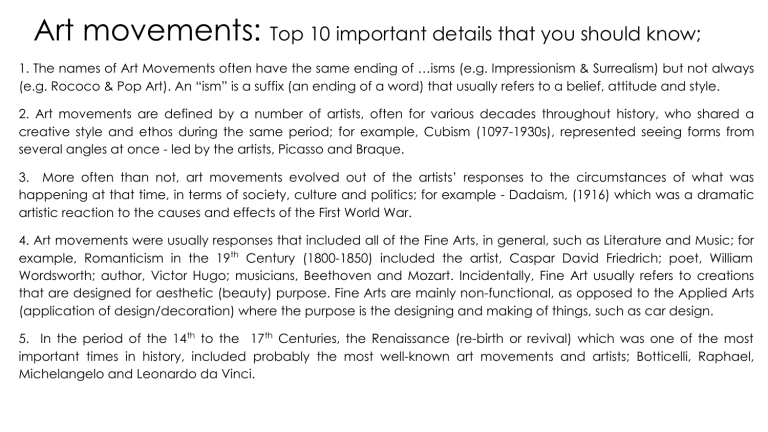
Art movements: Top 10 important details that you should know; 1. The names of Art Movements often have the same ending of …isms (e.g. Impressionism & Surrealism) but not always (e.g. Rococo & Pop Art). An “ism” is a suffix (an ending of a word) that usually refers to a belief, attitude and style. 2. Art movements are defined by a number of artists, often for various decades throughout history, who shared a creative style and ethos during the same period; for example, Cubism (1097-1930s), represented seeing forms from several angles at once - led by the artists, Picasso and Braque. 3. More often than not, art movements evolved out of the artists’ responses to the circumstances of what was happening at that time, in terms of society, culture and politics; for example - Dadaism, (1916) which was a dramatic artistic reaction to the causes and effects of the First World War. 4. Art movements were usually responses that included all of the Fine Arts, in general, such as Literature and Music; for example, Romanticism in the 19th Century (1800-1850) included the artist, Caspar David Friedrich; poet, William Wordsworth; author, Victor Hugo; musicians, Beethoven and Mozart. Incidentally, Fine Art usually refers to creations that are designed for aesthetic (beauty) purpose. Fine Arts are mainly non-functional, as opposed to the Applied Arts (application of design/decoration) where the purpose is the designing and making of things, such as car design. 5. In the period of the 14th to the 17th Centuries, the Renaissance (re-birth or revival) which was one of the most important times in history, included probably the most well-known art movements and artists; Botticelli, Raphael, Michelangelo and Leonardo da Vinci. 6. Those art movements ending with “isms” mainly relate from the early 20th Century and predominantly in the “Western World” and are due to Modernism (“out with the old & in with the new!”) – A time of great change with the growth of the Industrial Age. 7. Avant-garde (innovative & experimental) is a term that is associated with those artists who are seen to push the boundaries of what has come before, particularly in cultural acceptance. Therefore, such artists aim to challenge shock and provoke. This is demonstrated by the artists such as Damien Hirst and his shark in formaldehyde. 8. Although most of the art research that relates to Art Movements is predominantly connected with “Western World” countries, specific periods of Art are identified in many countries/cultures throughout the world. 9. Although historically, most art movements are categorized by artworks that are produced in the major media, including drawing, painting, print-making and sculpture. More recently, new and emerging media are often mixed together, such as collage, animation, video and installation 10. Art movements are often sequential; in that they are derived from what has come before and they go on to affect the art movements that follow afterwards. JR street artist Rain room at MOMA Jeff Koons Renaissance (1495 - 1520) : Da Vinci, Michelangelo, Botticelli... Renaissance means “rebirth”. It was a time when individual expression and worldly experience became two of the main themes of Renaissance art. The movement owed a lot to the increasing sophistication of society, characterised by political stability, economic growth and cosmopolitanism. Education blossomed at this time, with libraries and academies allowing more thorough research to be conducted into the culture of the antique world. To make paintings and sculptural reliefs look three dimensional. Renaissance artists worked out the mathematical laws of perspective. Many of these artists came from Florence and it remained an important centre for the Renaissance into the 16th century eventually to be overtaken by Rome and Venice. Rococo (1715 -1760): Watteau Rococo is Baroque art in excess. This was an art favored by kings, princes and prelates who had too much money to spend. The ornamental quality of Rococo painting, relief, sculpture, and architecture is often more important than the subject matter. Baroque art: is a highly ornate and often extravagant style of architecture, art and music that flourished in Europe from the early 17th until the late 18th century. The baroque style used contrast, movement, exuberant detail, grandeur and surprise to achieve a sense of awe. Such as the palace de Versailles. Romanticism (late 1700s - early 1800s) : Delacroix Romanticism occurred during the American, French, and Industrial revolutions. They chose their style of art usually to convey a political and/or spiritual message. Romantic artists shunned the Industrial Revolution, attacked the excesses of kings, and championed the rights of the individual. Some took refuge in nature; others sought and invigorating mixture of fear and awe in sublime landscapes and seascapes. IMPRESSIONISM (1869 - 1880s): Cezanne, Monet, Gauguin... Impressionism can be considered the first distinctly modern movement in painting. Its originators were artists who rejected the official, government-sanctioned exhibitions and were consequently shunned by powerful academic art institutions. In turning away from the fine finish and detail to which most artists of their day aspired to, the Impressionists aimed to capture the momentary, sensory effect of a scene - the impression objects made on the eye in a fleeting instant. To achieve this effect, many Impressionist artists moved from the studio to the streets and countryside, painting en plein air, painting everyday life in natural light. Their brushwork loosened and their palettes lightened to include pure, intense colors. They abandoned traditional linear perspective and avoided the clarity of form that had previously served to distinguish the more important elements of a picture from the lesser ones. For this reason, many critics faulted Impressionist paintings for their unfinished appearance and seemingly amateurish quality. Fauvism (1905 - 1908) The Fauves ("wild beasts") were a loosely allied group of French painters with shared interests. Matisse emerged as the leader of the group, whose members shared the use of intense color as a vehicle for describing light and space, and who redefined pure color and form as means of communicating the artist's emotional state. In these regards, Fauvism proved to be an important precursor to Cubism and Expressionism as well as a touchstone for future modes of abstraction. Fauvism pushed art in the direction of abstraction by simplifying or distorting form and by using expressive rather than naturalistic colors. CUBISM (1908 - 1920) : Braque, Picasso... In Cubist artwork, objects are analyzed, broken up and reassembled in an abstracted form—instead of depicting objects from a single viewpoint, the artist depicts the subject from a multitude of viewpoints to represent the subject in a greater context. George Braque and Pablo Picasso invented cubism so people could observe all views of a person or an object at once, from any angle. Cubism has been considered to be among the most influential art movements of the 20th century. Dadaism (1916 - 1922) It is an artistic movement in modern art that started around World War I. Its purpose was to ridicule the meaninglessness of the modern world. It influenced surrealism, pop art, and punk rock. It favored going against the standards of society. Followers of Dadaism included Antonin Artaud, Max Ernst, and Salvador Dali. A later version, called Neo-Dada, arose in the 1960s. Surrealism (1924 - 1940s) : Dali, Magritte... The Surrealists sought to channel the unconscious as a means to unlock the power of the imagination. They hoped that the psyche had the power to reveal the contradictions in the everyday world and spur on revolution. Their emphasis on the power of personal imagination puts them in the tradition of Romanticism, but unlike the romantics, they believed that revelations could be found on the street and in everyday life. They painted their dreams and mixed up the rational order of life in their art, by juxtaposing objects that don’t normally fit together: a melting clock hanging from a dead tree branch. Expressionism Pop art (1960): Andy Warhol... Pop art started with the New York artists Andy Warhol, Roy Lichtenstein, James Rosenquist, and Claes Oldenburg, all of whom drew on popular imagery and were actually part of an international phenomenon. Following the popularity of the Abstract Expressionists, Pop's reintroduction of identifiable imagery (drawn from mass media and popular culture) was a major shift for the direction of modernism. The subject matter became far from traditional "high art" themes of morality, mythology, and classic history; rather, Pop artists celebrated commonplace objects and people of everyday life, in this way seeking to elevate popular culture to the level of fine art. Perhaps owing to the incorporation of commercial images, Pop art has become one of the most recognizable styles of modern art. Contemporary Art
